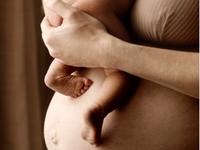Pregnancy is definitely the time in a woman’s life that she either learns about or dives deeper into understanding the pelvic floor muscles. This is typically because women realize the importance of supporting their bodies during pregnancy, and the eventual role in delivery and recovery postpartum. And having a greater understanding of your pelvic floor will prepare you for the birth of your baby and the recovery afterward.
So what is the pelvic floor anyway?
The pelvic floor is a group of muscles at the base of the pelvis responsible for supporting the structure of the pelvic girdle that controls your bowel, bladder and one's sexual function. These are big and important jobs in a woman’s body and become highlighted during pregnancy. Hormonal shifts can create more laxity in the joints throughout pregnancy, so the muscles in your body have to step it up a bit to give more support. And during pregnancy, a woman has an ever-growing weight (also known as your baby) resting on top of the pelvic floor muscles, requiring them to work harder.
During the second trimester, you are hopefully moving on from morning sickness, maybe showing a belly now, and are possibly beginning to plan for delivery. This is a perfect time to learn more about the pelvic floor and how it relates to your pregnancy.
Do I need to do Kegels every day during pregnancy?
Kegels are not for every pregnant woman. A kegel is the contraction of the pelvic floor muscles. If a woman has been assessed with a truly weak pelvic floor, then Kegels are one piece of the puzzle to help her strengthen those muscles. But as a general approach, it is more important to be able to fully contract and relax the pelvic floor muscles. Being able to feel those muscles move and connect that movement with breath is universally important during pregnancy.
What types of movement or exercise is good for the pelvic floor during pregnancy?
Diaphragmatic breathing is key to good pelvic floor health. This is when you fully breathe into the rib cage and allow the diaphragm and the pelvic floor muscles to drop down, or lengthen. On the exhale, the rib cage returns back as the diaphragm and pelvic floor muscles move up, or contract. This technique is the foundation of movement and understanding it will give women much more freedom with the type of movement they choose and less fear about “doing the right thing.” As a general rule of thumb, I encourage women to do some cardio, resistance training, and breathing or mindfulness practices.
Does pelvic floor strengthening prepare me for labor and delivery?
It’s more about the pelvic floor connection really than pelvic floor strengthening. Having the ability to lengthen the pelvic floor will help tremendously with vaginal delivery since that is exactly what needs to happen in order to birth your baby. Therefore, if you can teach your body this early in your pregnancy, you’ll be more likely to tap into that when you’re in labor. It is a helpful muscle memory to have.
$41.14
First 3 Mo
First 3 Months
$41.14
First 3 Mo
First 3 Months
$41.14
First 3 Mo
First 3 Months
Shop the Article:


1st Trimester Prenatal Pack
Shop Now


2nd Trimester Prenatal Pack
Shop Now


3rd Trimester Prenatal Pack
Shop Now
Are you doing pelvic floor exercises to prepare for labor? Tell us by joining the Perelel community on social or by subscribing to our newsletter.
Sign up to receive doctor-backed, stage-specific content in your inbox each week.
theFolio in Your Inbox
Allison Oswald is a board-certified women's health Doctor of Physical Therapy. She has a passion for holistic pelvic care and works with women during preconception, pregnancy, postpartum and throughout menopause. She offers one-on-one home sessions or virtual sessions with clients and leads an online postnatal education series to optimize your pelvic health. She is a mother of three, a wife, a daughter, and a sister.
This article is for informational purposes only. It is not, nor is it intended to be, a substitute for professional medical advice, diagnosis, or treatment and we recommend that you always consult with your healthcare provider. To the extent that this article features the advice of physicians or medical practitioners, the views expressed are the views of the cited expert and do not necessarily represent the views of Perelel.






















